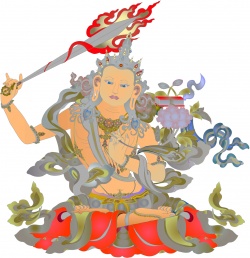Three samadhis
Jump to navigation
Jump to search
- See also :
- See also :
The three samadhis (Skt. trisamādhi; Tib. tingédzin nampa sum; Wyl. ting nge 'dzin rnam pa gsum), an important aspect of kyerim practice presented in the Mahayoga tantras, are as follows:
- the samadhi of as-it-isness (Tib. deshyin nyi kyi tingédzin; Wyl. de bzhin nyid kyi ting nge 'dzin)
- the samadhi of universal manifestation (Tib. küntu nangwé tingédzin; Wyl. kun tu snang ba'i ting nge 'dzin)
- the causal samadhi (Tib. gyü tingédzin; Wyl. rgyu'i ting nge 'dzin)
Sogyal Rinpoche writes:
- The development stage consists of three phases, known as ‘the three samadhis’.
- The practice of Mahayoga begins with meditation on emptiness, the ‘samadhi of as-it-isness’ where all phenomena are realized as empty in their pure nature. This is the realization of absolute bodhichitta.
- From this state arise exuberant waves of compassion in what is known as the ‘samadhi of all-perceiving compassion’. This is the realization of relative bodhichitta.
- The union of these two is known as the [causal samadhi], in which state arises a seed-syllable, from which rays of light emerge, purifying the entire environment of samsara and the beings within it into the nature of emptiness. One’s mind becomes this seed-syllable, which in turn transforms into the pure appearance of the deity. The mandala is seen as the palace of the deity. The form of the deity is the indivisible appearance of skilful means and wisdom. All experience is perceived as the retinue and activity of the deity. As one realizes that all perceptions, sounds and thoughts are the vajra nature, one rests in this state of vajra dignity.[1]
Footnotes
- ↑ Sogyal Rinpoche, The Nine Yanas, published by Zam, pages 13-14.
Alternative Translations
- the three absorptions (Dharmachakra Translation Committee):
Further Reading
- A Guide to Vajrayana Practice for the Rigpa Sangha (Lodeve: The Tertön Sogyal Trust, 2006), Section 2. 'Kyérim', pages 6-12.
- His Holiness Dilgo Khyentse Rinpoche, Pure Appearance—Development and Completion Stages in the Vajrayana Practice (Halifax: Vajravairochana Translation Committee, 2002), pages 18-28. restricted publication
- Jigme Lingpa, Patrul Rinpoche, and Getse Mahapandita, Deity, Mantra and Wisdom: Development Stage Meditation in Tibetan Buddhist Tantra, translated by the Dharmachakra Translation Committee (Ithaca: Snow Lion, 2007), pages 31-36 & pages 110-113.
- Padmasambhava and Jamgön Kongtrül, The Light of Wisdom, Vol II, translated by Erik Pema Kunsang (Boudhanath, Hong Kong & Esby: Rangjung Yeshe, 1998), pages 87-92.
